
Rifle grenade
Encyclopedia
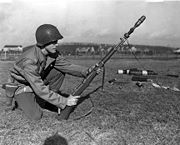
Grenade
A grenade is a small explosive device that is projected a safe distance away by its user. Soldiers called grenadiers specialize in the use of grenades. The term hand grenade refers any grenade designed to be hand thrown. Grenade Launchers are firearms designed to fire explosive projectile grenades...
that uses a rifle
Rifle
A rifle is a firearm designed to be fired from the shoulder, with a barrel that has a helical groove or pattern of grooves cut into the barrel walls. The raised areas of the rifling are called "lands," which make contact with the projectile , imparting spin around an axis corresponding to the...
-based launcher to permit a longer effective range than would be possible if the grenade was thrown by hand. The practice of projecting grenades with rifle-mounted launchers was first widely used during World War I
World War I
World War I , which was predominantly called the World War or the Great War from its occurrence until 1939, and the First World War or World War I thereafter, was a major war centred in Europe that began on 28 July 1914 and lasted until 11 November 1918...
and continues to the present, with the term "rifle grenade" now encompassing many different types of payloads including high explosive, fragmentation, and anti-tank warheads as well as concussion, smoke, incendiary, and flare missiles. Many armies have replaced rifle grenades with dedicated grenade launcher
Grenade launcher
A grenade launcher or grenade discharger is a weapon that launches a grenade with more accuracy, higher velocity, and to greater distances than a soldier could throw it by hand....
s - often attached as an auxiliary weapon on a rifle.
Advantages and disadvantages
A rifle-grenade has these principal advantages compared to a standard hand-grenade:- A rifle-grenade can be projected to a much greater distance than a hand-grenade.
- A rifle-grenade can carry a larger, heavier payload than a hand-grenade.
- A rifle-grenade can effectively project a shaped charge warhead which can penetrate armor.
- A rifle-grenade is more accurate than a hand-grenade.
- A rifle-grenade has the advantage of detonating upon impact.
Offsetting these strengths are the greater weight and bulk of rifle-grenades compared to most hand-grenades, combined with very high levels of recoil.
In comparison to a dedicated grenade launcher
Grenade launcher
A grenade launcher or grenade discharger is a weapon that launches a grenade with more accuracy, higher velocity, and to greater distances than a soldier could throw it by hand....
, the rifle-grenade has two main advantages:
- Rifle-grenades can use a variety of different sizes and shapes of warheads and payloads.
- Rifle-grenades can be projected from any infantry rifle fitted with an appropriate muzzle base or spigot tube fitting. In essence, every soldier armed with a NATO STANAG rifle can be a grenadier.
The primary disadvantages of rifle grenades is that they're relatively inaccurate and use of standard rifle grenades will temporarily disable the normal use of the rifle. This has increasingly led to the adoption of specialized low-velocity grenade launchers (using integrated shell/warheads) mounted to the rifle in a manner that does not obstruct immediate use of the rifle, such as underneath the rifle barrel. With the latter arrangement, the grenade launcher/rifle can be carried ready for immediate use. Low-velocity grenade launchers can also be fired from the shoulder without undue discomfort, something not normally possible with a rifle-launched grenade.
Operation
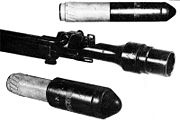
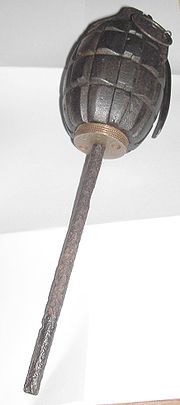
- A stick that fits down the interior of the rifle barrelGun barrelA gun barrel is the tube, usually metal, through which a controlled explosion or rapid expansion of gases are released in order to propel a projectile out of the end at a high velocity....
; - A cup or special adapter that fitted on the end of the rifle muzzle.
For both these methods, a blank cartridge
Blank (cartridge)
A blank is a type of cartridge for a firearm that contains gunpowder but no bullet or shot. When fired, the blank makes a flash and an explosive sound . Blanks are often used for simulation , training, and for signaling...
was required; in the former case, it propelled both the stick and the grenade. It was found that repeated use of a rifle for launching grenades by this method caused damage to the barrel, which is what led to the cup/adapter technique. The need to load a blank cartridge at the same time as the rifle grenade proved difficult in combat. Attempting to use a live round with either a stick or cup grenade launcher would have disastrous results.
The problem with having to load special ammunition has been addressed with the modern concepts of the "bullet trap" and "bullet through" rifle grenades. The SIMON breach grenade
SIMON breach grenade
The SIMON is a rifle grenade designed to breach through doors, developed by Rafael Advanced Defense Systems. It is intended for use with 5.56 mm rifles such as the M4 carbine.-Overview:...
, for example, "traps" the live ball or tracer round within the grenade, and uses its energy for propulsion. "Bullet through" grenades, as for example the French Viven Bessieres (VB) used in World War I, have a hole through the middle that permits the passage of a standard bullet, and use the expanding gas to propel the grenade. Both of these methods remove the need for a special blank round to be loaded to launch.
Rifle grenades can be of any type as the more conventional hand grenade
Hand grenade
A hand grenade is any small bomb that can be thrown by hand. Hand grenades are classified into three categories, explosive grenades, chemical and gas grenades. Explosive grenades are the most commonly used in modern warfare, and are designed to detonate after impact or after a set amount of time...
s. However, two types predominate — fragmentation grenades, for use against personnel; and shaped charge
Shaped charge
A shaped charge is an explosive charge shaped to focus the effect of the explosive's energy. Various types are used to cut and form metal, to initiate nuclear weapons, to penetrate armor, and in the oil and gas industry...
s for use against armoured fighting vehicles. Rifle grenades may be time-fuse
Fuse (explosives)
In an explosive, pyrotechnic device or military munition, a fuse is the part of the device that initiates function. In common usage, the word fuse is used indiscriminately...
d, so that they detonate
Detonation
Detonation involves a supersonic exothermic front accelerating through a medium that eventually drives a shock front propagating directly in front of it. Detonations are observed in both conventional solid and liquid explosives, as well as in reactive gases...
at a fixed time after firing, or impact-fused, so they detonate upon impact. Generally, anti-personnel grenades are time-fused, and anti-armour grenades are impact-fused, though there are exceptions. A third type of rifle grenade is more rarely encountered, which uses a high explosive (HE) warhead. The high explosive warhead relies on blast effect rather than fragmentation to cause enemy casualties.
Often, special sights that attach onto the rifle to provide aiming for the grenade's particular ballistics
Ballistics
Ballistics is the science of mechanics that deals with the flight, behavior, and effects of projectiles, especially bullets, gravity bombs, rockets, or the like; the science or art of designing and accelerating projectiles so as to achieve a desired performance.A ballistic body is a body which is...
are employed. Since rifle grenades usually travel at low velocities with very high trajectories, their range is measured in tens of yards (meters). The maximum range of most rifle grenades was about 200 yards (180 m). Rifle grenades are often fired at angles greater than 45 degrees
Degree (angle)
A degree , usually denoted by ° , is a measurement of plane angle, representing 1⁄360 of a full rotation; one degree is equivalent to π/180 radians...
, allowing them to drop down at steep angles to enter trenches, or to hit targets behind cover; the steep angle also increased the time of flight, to give the fuse more time to burn, so it would detonate as soon as possible after reaching the target. Firing at lower angles was useful for placing grenades through windows or other vertical openings.
History
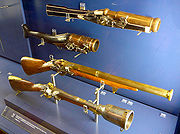
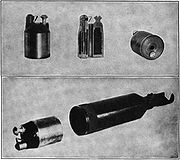
Battle of Port Arthur
The Battle of Port Arthur was the starting battle of the Russo-Japanese War...
in the Russo-Japanese War
Russo-Japanese War
The Russo-Japanese War was "the first great war of the 20th century." It grew out of rival imperial ambitions of the Russian Empire and Japanese Empire over Manchuria and Korea...
, and the idea was further used by the Spanish, though the French were the first to put it to widespread use during the trench warfare
Trench warfare
Trench warfare is a form of occupied fighting lines, consisting largely of trenches, in which troops are largely immune to the enemy's small arms fire and are substantially sheltered from artillery...
of World War I
World War I
World War I , which was predominantly called the World War or the Great War from its occurrence until 1939, and the First World War or World War I thereafter, was a major war centred in Europe that began on 28 July 1914 and lasted until 11 November 1918...
.
The French grenade, named the V-B grenade after its inventors, Vivien and Bessières, was fired from the standard service rifle with the use of a special adapter and a standard cartridge, providing an effective range of around 175 to 200 yards, while the effective radius of the bursting grenade was 75 yards. The grenade had a hollow through the middle, allowing the bullet to pass through, while the muzzle blast was captured by the launching device and used to propel the grenade. The bullet, after passing through the body of the grenade, struck a small plate that ignited primer. This then lit the fuse in the grenade, providing an eight second delay before detonation. It could be fired from the shoulder, but due to the heavy recoil and poor balance of the rifle fitted with the grenade, it was more common to fire it with the butt of the rifle resting on the ground, and either held at an appropriate angle, or resting on a tripod. The rifle grenade was useful in offense, particularly in attacking sandbag fortified machine gun nests, as well as in defense. Eight men armed with rifle grenades could fire 150 shots in a minute, providing a heavy barrage to break up an attacker's lines.
Upon entering World War I, the United States attempted to adopt the V-B grenade, but this was not very successful. The difference between the French and American service cartridges (8 mm vs. 7.62 mm) meant that the grenade had to be re-designed with a smaller hole, but even this was not sufficient to ensure reliable functioning, due to differences in bullet design. The American bullet would often break apart in the grenade, and this led to the V-B derived grenade design being scrapped in May 1918.
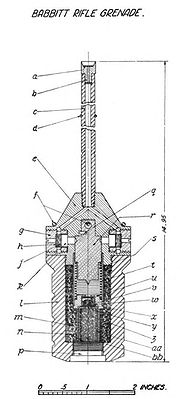
After World War I, the rifle grenade was steadily modified to increase its effectiveness when launched from the rifle. The Japanese Army continued to experiment with rifle and hand-thrown grenades between the wars, and appear to be the first to have developed the rifle grenade as part of an entire weapons system. As part of this new concept, the Japanese Army adopted a new series of grenades, along with a new type of rifle grenade launcher. Rather than using the old cup-type launcher, like the French V-B grenade, the Japanese rifle grenade launcher was much smaller and lighter, and did not obstruct normal use of the rifle or its sights. Clamped to the muzzle of the rifle, a corresponding hollow-based, finned grenade fitted over the launcher tube, or spigot. The resulting assembly superficially resembled a spigot mortar, and became known in the West as a 'spigot' rifle grenade launcher. These spigot launchers still used special grenade-launching blank cartridges for firing.
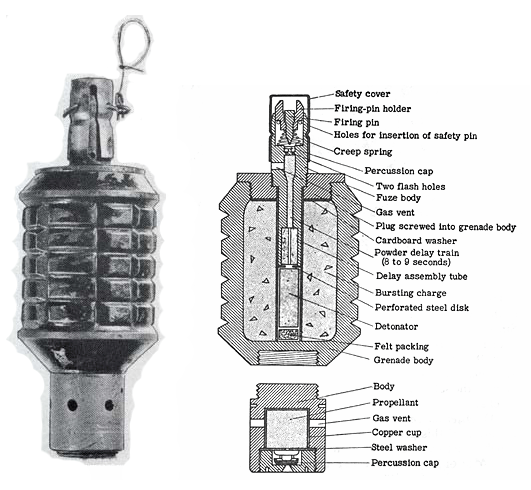
Type 89 Grenade Discharger
The , inaccurately known as a knee mortar by Allied forces, is a Japanese grenade launcher or light mortar that was widely used in the Pacific during the Second World War.-Background:...
, or knee mortar), or fitted with a stem and tail fins and fired from a spigot-type launcher as a rifle grenade. As the Type 91 grenade was fitted with a time fuse, it did not explode upon contact, and was designed to ignite its fuse while in flight when fired from the spigot launcher. Instead, a weak creep spring inside the grenade firing mechanism caused the firing pin to be thrown back upon launching, igniting the time fuse. Using this system, Japanese rifle grenades could be launched right through jungle cover or through small openings without the danger of premature detonation in the event the grenade struck an object on its way to the target.
The Italian Army adopted an unusual spigot-type 38.5 mm rifle grenade launcher bolted to the side of a normal Carcano
Carcano
Carcano is the frequently used name for a series of Italian bolt-action military rifles and carbines. Introduced in 1891, this rifle was chambered for the rimless 6.5x52mm Mannlicher-Carcano Cartuccia Modello 1895 cartridge. It was developed by the chief technician Salvatore Carcano at the Turin...
6.5 mm carbine, the Moschetto di Fanteria Mod. 91/28 con Tromboncino. In use, the rifle's bolt was removed and installed in the spigot launcher. The rifle was placed butt-first against the ground, a grenade blank and grenade were loaded, and the grenade was launched. The necessity of changing the rifle bolt kept the rifle out of use until the bolt could be replaced, a slow and clumsy procedure. The bolt-changing procedure could also result in lost rifle bolts in the heat of battle, putting the weapon out of action completely. As a result, this design was not adopted by any other nation. Today, it can be seen as an early, if unsuccessful ancestor of today's M203
M203 grenade launcher
The M203 is a single shot 40 mm grenade launcher designed to attach to a rifle. It uses the same rounds as the older M79 break-action grenade launcher, which utilize the High-Low Propulsion System to keep recoil forces low. Though versatile, and compatible with many rifle models, the M203 was...
under-barrel grenade launcher.
In the years just prior to World War II, more and more countries adopted spigot-type rifle grenade launchers and various finned rifle grenades, using anti-personnel (fragmentation) as well as anti-tank warheads. Another trend was seen in the development of 'bullet trap' rifle grenades, designed to dispense with the need to use blank rifle grenade ammunition. The bullet trap rifle grenade had a cavity through its center. Upon firing, the bullet passed through the grenade body, transferring its momentum to the grenade, which flew to its target and detonated in the usual manner.
Having come into wide acceptance during World War II, rifle grenades were increasingly used in the years after the war, including the wars in Korea
Korean War
The Korean War was a conventional war between South Korea, supported by the United Nations, and North Korea, supported by the People's Republic of China , with military material aid from the Soviet Union...
, Algeria, and the early years of the Vietnam War
Vietnam War
The Vietnam War was a Cold War-era military conflict that occurred in Vietnam, Laos, and Cambodia from 1 November 1955 to the fall of Saigon on 30 April 1975. This war followed the First Indochina War and was fought between North Vietnam, supported by its communist allies, and the government of...
. More and more countries adopted anti-tank rifle grenades with shaped-charge or HEAT warheads to enable infantrymen to defeat the thicker tank armour then coming into service. The Belgian ENERGA anti-tank rifle grenade
ENERGA anti-tank rifle grenade
The Energa anti-tank rifle grenade is a rifle-launched anti-tank grenade that is propelled by a ballistite-filled blank cartridge. The name Energa comes from the firm in Liechtenstein that designed it, the Anstalt für die ENtwicklung von ERfindungen und Gewerblichen Anwendungen, based in...
design in particular was widely adopted by several Western nations. The 'bullet trap' rifle grenade design also saw increasing use during the years after World War II. Rifle grenade launchers were further simplified, and sometimes constructed as an integral part of the rifle itself. Eventually, most modern rifles began to use shortened spigot-base rifle grenade launchers incorporated into the rifle's own integral flash hider or muzzle compensator.
By the late 1970s, rifle grenades and their launchers began to be replaced by designated grenade launcher
Grenade launcher
A grenade launcher or grenade discharger is a weapon that launches a grenade with more accuracy, higher velocity, and to greater distances than a soldier could throw it by hand....
s. First seen in the United States armed forces, these grenade launchers generally took form of either separate weapons (the M79 grenade launcher
M79 grenade launcher
The M79 grenade launcher is a single-shot, shoulder-fired, break-action grenade launcher that fires a 40x46mm grenade which used what the US Army called the High-Low Propulsion System to keep recoil forces low, and first appeared during the Vietnam War...
), or as an under-barrel attachment to an assault rifle
Assault rifle
An assault rifle is a selective fire rifle that uses an intermediate cartridge and a detachable magazine. Assault rifles are the standard infantry weapons in most modern armies...
(the most common example being the M203
M203 grenade launcher
The M203 is a single shot 40 mm grenade launcher designed to attach to a rifle. It uses the same rounds as the older M79 break-action grenade launcher, which utilize the High-Low Propulsion System to keep recoil forces low. Though versatile, and compatible with many rifle models, the M203 was...
attached to M16/M4
M4 Carbine
The M4 carbine is a family of firearms tracing its lineage back to earlier carbine versions of the M16, all based on the original AR-15 designed by Eugene Stoner and made by ArmaLite. It is a shorter and lighter variant of the M16A2 assault rifle, with 80% parts commonality.It is a gas-operated,...
-family of rifles).
Today, there is a return to the concept of the rifle grenade, such as the M16's SIMON breach grenade
SIMON breach grenade
The SIMON is a rifle grenade designed to breach through doors, developed by Rafael Advanced Defense Systems. It is intended for use with 5.56 mm rifles such as the M4 carbine.-Overview:...
and the IMI Tavor's "Rephaim" advance grenade. Modern combination doctrine designates a certain percentage of grenadiers, or soldiers equipped with a grenade launcher or combination rifle/grenade launcher. The criticism of this doctrine is that if the grenadiers in a group are disabled or separated from the group, then the group has completely lost the grenade launcher as a heavy fire support. With rifle grenades, each soldier would be equipped with a small number of grenades, so every individual soldier could use some form of heavy firepower.
All current NATO rifles are capable of launching STANAG
STANAG
STANAG is the NATO abbreviation for Standardization Agreement, which sets up processes, procedures, terms, and conditions for common military or technical procedures or equipment between the member countries of the alliance. Each NATO state ratifies a STANAG and implements it within their own...
type 22mm rifle grenades from their integral flash hiders without the use of an adapter. These 22mm grenade types range from powerful anti-tank rounds to simple finned tubes with a fragmentation hand grenade attached to the end. They come in "standard" type which are propelled by a blank cartridge inserted into the chamber of the rifle. The newer "bullet trap" and "shoot through" types, as their names imply use live ammunition. The U.S. military does not generally use rifle grenades, however they are used by other Nations. It should be noted, that all of these rifle grenades add additional weight to the soldiers war-load and as a consequence they must reduce the amount rifle ammunition that they carry. For example, a modern French APAV40
APAV40
The APAV 40 is a 40 mm anti-personnel rifle grenade used by the French Army.-Design:The APAV 40 is a dual purpose, anti-personnel and anti-vehicle , 40 mm rifle-grenade...
"bullet trap" rifle grenade weighs .5 kg, the equivalent of a loaded M16 magazine.
Anti-tank
Britain put the first anti-tank grenade into the field during World War II in late 1940 with the No 68 AT Grenade, which was one of the first "any" type anti-tank weapons of the shape charge or HEAT type.Non-lethal use

Riot shotgun
A riot shotgun is a shotgun designed or modified for use as a primarily defensive weapon, primarily by the use of a short barrel. The riot shotgun is used by military personnel for guard duty and was at one time used for riot control, and is commonly used as a patrol weapon by law enforcement...
s, not rifles. These systems use a cup-type launcher attached to the muzzle of the gun to launch various less lethal grenade types.
Propaganda grenade
During the Second World War, Nazi GermanyNazi Germany
Nazi Germany , also known as the Third Reich , but officially called German Reich from 1933 to 1943 and Greater German Reich from 26 June 1943 onward, is the name commonly used to refer to the state of Germany from 1933 to 1945, when it was a totalitarian dictatorship ruled by...
developed and fielded a propaganda
Propaganda
Propaganda is a form of communication that is aimed at influencing the attitude of a community toward some cause or position so as to benefit oneself or one's group....
rifle grenade (Gewehr Propaganda Granate). It was designed for front-line troops to disperse propaganda leaflets via a rifle grenade that, on impact, would disperse the printed material via a small ejecting charge.
Legal issues
In almost all countries, grenades are illegal for civilian ownership.In the United States
United States
The United States of America is a federal constitutional republic comprising fifty states and a federal district...
, rifle grenades containing explosive material are covered under the National Firearms Act
National Firearms Act
The National Firearms Act , 73rd Congress, Sess. 2, ch. 757, , enacted on June 26, 1934, currently codified as amended as , is an Act of Congress that, in general, imposes a statutory excise tax on the manufacture and transfer of certain firearms and mandates the registration of those firearms. The...
as "destructive device
Destructive device
In the United States, a destructive device is a firearm or explosive device regulated by the National Firearms Act of 1934.Examples of destructive devices include grenades, and firearms with a bore over one half of an inch, including some semi-automatic shotguns. While current federal laws allow...
s". Inert rifle grenades are not federally regulated, nor are rifle grenade launching attachments and devices. However, such items may be restricted by local legislation, as is the case in California
Gun laws in California
Gun laws in California regulate the sale, possession, and use of firearms and ammunition in the state of California in the United States.The gun laws of California are some of the strictest in the United States...
.
See also
Rifle grenades:- ENERGA anti-tank rifle grenadeENERGA anti-tank rifle grenadeThe Energa anti-tank rifle grenade is a rifle-launched anti-tank grenade that is propelled by a ballistite-filled blank cartridge. The name Energa comes from the firm in Liechtenstein that designed it, the Anstalt für die ENtwicklung von ERfindungen und Gewerblichen Anwendungen, based in...
- M31 HEAT rifle grenadeM31 HEAT rifle grenadeThe M31 HEAT is a fin-stabilized anti-tank rifle grenade designed in the late 1950s to replace the Belgian ENERGA rifle grenade which was adopted by the US Army and US Marines as an emergency stop-gap measure during the Korean War...
- APAV40APAV40The APAV 40 is a 40 mm anti-personnel rifle grenade used by the French Army.-Design:The APAV 40 is a dual purpose, anti-personnel and anti-vehicle , 40 mm rifle-grenade...
(French rifle grenade) - Stielgranate 41Stielgranate 41The Stielgranate 41 stick grenade was a German shaped charge, fin-stabilized shell, used with the 3.7 cm Pak 36 anti-tank gun to give it better anti-tank performance....
(German WW2 anti-tank gun barrel grenade)
Comparable weaponry:
- Grenade launcherGrenade launcherA grenade launcher or grenade discharger is a weapon that launches a grenade with more accuracy, higher velocity, and to greater distances than a soldier could throw it by hand....
- Type 89 grenade dischargerType 89 Grenade DischargerThe , inaccurately known as a knee mortar by Allied forces, is a Japanese grenade launcher or light mortar that was widely used in the Pacific during the Second World War.-Background:...
(Japanese mortar-type weapon) - Hand mortarHand mortarThe hand mortar is a firearm that was used in the late 17th century and 18th century to throw fused grenades. The action was similar to a flintlock, matchlock, or wheellock firearm , but the barrel was short, usually less than 2 inches to 4 inches long , and had a...
Other links:
- Portuguese Colonial Wars
External links
- http://www.firstworldwar.com/weaponry/graphics/serbiangrenade.jpg
- Carcano Model 91/28 with Tromboncino

